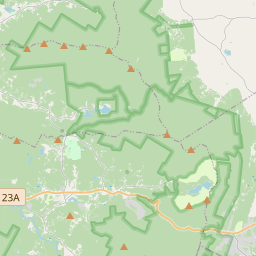Tannersville
Historical marker location:
6372 NY-23A, Tannersville, New York
( Marker is at the intersection of New York State Route 23A and Raspberry Lane, on the left when traveling east on State Route 23A.)







© OpenStreetMap contributors
The Painted Village In The Sky. Historic Tannersville: Tanneries & Tourism
Loading...
Searching for other points of interest within 3 miles of this location.The Stonewall Inn in Greenwich Village, New York City, was the site of the Stonewall riots in 1969, which are considered the birth of the modern gay rights movement.
About Greene County
Greene County Timeline
Greene County is located in the state of New York and holds a rich history that dates back to the early colonial times. The area that is now Greene County was originally inhabited by Native American tribes, primarily the Mohican people. European settlers, mainly Dutch and English, began to establish settlements in the region during the 17th century.
In 1800, Greene County was officially established, named after General Nathanael Greene, a hero of the American Revolutionary War. The region flourished economically, as it was situated along the Hudson River and easily accessible to trade routes. The construction of the Erie Canal in the 19th century further boosted the county's growth, connecting it to the Great Lakes and opening up avenues for transportation and commerce.
Throughout the 1800s, various industries thrived in Greene County, including flour mills, sawmills, and tanneries. The towns of Catskill and Cairo became major centers of trade and manufacturing. The arrival of the railroad in the mid-19th century further fueled economic development and facilitated the transportation of goods and people.
In the early 20th century, the tourism industry began to emerge as visitors flocked to the region to enjoy its natural beauty, including the Catskill Mountains and numerous lakes and rivers. Resorts and hotels were built, attracting vacationers from New York City and other urban areas. Today, Greene County continues to be a popular destination for outdoor recreation and tourism, with a strong focus on eco-tourism and preserving its natural resources.
Overall, Greene County's history is characterized by its early settlement, industrial growth, and later transition into a tourist destination. It serves as a testament to the diverse and evolving nature of the region and its ability to adapt to changing economic trends.
In 1800, Greene County was officially established, named after General Nathanael Greene, a hero of the American Revolutionary War. The region flourished economically, as it was situated along the Hudson River and easily accessible to trade routes. The construction of the Erie Canal in the 19th century further boosted the county's growth, connecting it to the Great Lakes and opening up avenues for transportation and commerce.
Throughout the 1800s, various industries thrived in Greene County, including flour mills, sawmills, and tanneries. The towns of Catskill and Cairo became major centers of trade and manufacturing. The arrival of the railroad in the mid-19th century further fueled economic development and facilitated the transportation of goods and people.
In the early 20th century, the tourism industry began to emerge as visitors flocked to the region to enjoy its natural beauty, including the Catskill Mountains and numerous lakes and rivers. Resorts and hotels were built, attracting vacationers from New York City and other urban areas. Today, Greene County continues to be a popular destination for outdoor recreation and tourism, with a strong focus on eco-tourism and preserving its natural resources.
Overall, Greene County's history is characterized by its early settlement, industrial growth, and later transition into a tourist destination. It serves as a testament to the diverse and evolving nature of the region and its ability to adapt to changing economic trends.
Greene County Timeline
This timeline provides a concise overview of the key events in the history of Greene County, New York.
- 1600s: The area that is now Greene County was inhabited by various Native American tribes, including the Mohican and Lenape.
- 1609: Explorer Henry Hudson sailed up the Hudson River and made contact with the Native American tribes in the region.
- 1683: Greene County was part of Albany County, one of the original twelve counties of New York.
- 1788: The state of New York was divided into counties, and Greene County was officially established.
- 1800s: The construction of the Erie Canal brought economic growth and increased trade opportunities to Greene County.
- 1826: The town of Catskill became the county seat of Greene County.
- 1900s: Tourism became an important industry in Greene County due to its picturesque landscapes and proximity to the Catskill Mountains.
- 1969: The Woodstock Music Festival was held in Bethel, Sullivan County, which attracted thousands of attendees from across the country, including Greene County.
- Today, Greene County is known for its beautiful natural scenery, outdoor recreational activities, and charming small towns.